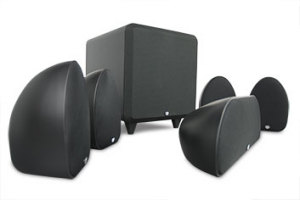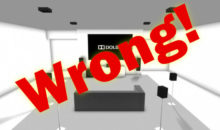Reconsidering Satellite Speakers in Home Theater
There was a time that I hated the idea of satellite speakers in home theater. For the most part it felt like these were poorly thought-out compromises that didn’t take into account the requirements for the deeper frequency ranges required to mesh well with a subwoofer and produce convincing home theater sound. With some systems that can still be the case. With a good pair of satellite speakers, however, you can achieve good quality sound while still taking into account the aesthetic needs of a room. That’s what I’m going to talk about in this article.
Easier Matching Satellite Speakers with a Subwoofer
One of the problems with some satellite systems is that they simply don’t blend well with the included sub, or even many aftermarket models. The issue is one of the speaker’s lowest frequency response range not matching up with the subwoofer’s upper range. A subwoofer, should really not go much higher than 80Hz if it is to remain “hidden” in the room and play those low frequencies without turning heads. You don’t want, for example, to hear dialogue coming out of a sub–it’s simply not designed for that. I am seeing more and more satellite speaker systems that are being engineered with passive radiators or ports to give them a deeper practical extension. This makes it easier for them to blend with a true subwoofer and keeps them from forcing a subwoofer to reach up into frequencies that will cause it to be noticed in the room. Even better, these new speakers actually sound better because they are able to fill in those critical midrange frequencies.
Satellite Speakers are Getting Better Aesthetics
This may seem rather simple, but the aesthetics of satellite speakers are starting to take on a more pleasing look. While you can still find the small rectangular box speakers of years past, you can also find some really beautiful designs that feature curves and more intelligently designed enclosures that allow for front or rear ports and better blending with flat panel televisions. It always perplexed me that “cube” speakers were the defacto standard in satellite-style systems. Now we”re starting to see flat, wide designs as well as rounded shapes that really push the envelop in terms of housing smaller 4″ and under drivers in an enclosure.

New and Improved Mounting Options
It used to be that satellite speakers could be ceiling mounted and that was about it. Typically, these mounts had articulating arms and looked more like tinker toy contraptions than aesthetic, well-designed mounts. As flat panel TVs began to drift away from squared, blocky edges, and towards a more streamlined, sophisticated look—speaker mounts are getting equally creative. With some of these modern systems, you’ll find them being designed for flush-mounting, as well as integrating keyhole mounts and threaded 1/4″ mounts for use with stands, wall, desk, and ceiling mounts.
As these satellite speakers for home theater evolve, so are the ways in which they can be integrated into the room.
Technology Advances in Sound Reproduction
An important area where satellite speakers are gaining ground—at least the better products—is with regard to sound quality. I have heard several systems lately (the RBH Sound CTx Speakers are a good example that comes to mind) where the enclosures are extremely deceptive and the all-important midrange detail is completely intact. Midrange is what typically suffers on satellite speakers, along with mid-bass. New techniques in porting speakers and utilizing the properties of concentric and other 2-way systems is leading to greater output and a more linear frequency response. What’s that mean for you? These speakers can reproduce a saxophone, or the female voice without sounding like you’re listening to your music over a telephone.
These systems are also starting to sound…well, bigger. In a recent demo (again back to the RBH CTx System) the perception was that we were hearing from their larger in-wall series speakers. The truth is, the CTx satellites and upgraded 10″ subwoofer were putting out a tremendous amount of volume that filled the room and delivered a very theatrical performance. And this isn’t the first system I’ve heard that can pull this off. The Polk Audio TL1 speakers shown above does it nearly as well.—and there are others
If you’re in the market for a home theater system, but can’t quite figure out how to blend your hobby into your living room, there’s hope. These new satellite speakers are reshaping what home theater can be and I’m seeing more and more people realize they have more choices available to them beyond “cube” speakers.








I plan to buy a bose cinemate 15 for my tv room 40 square mtrs floor area i don’t know if it sound better
I went with sony speakers to match my 52 inch Sony XBR flatscreen and 5.1 surround receiver: not that difficult to find the subwoofer, center channel, 3 way front left/right towers and matching 2 way rear speakers all made by sony and then simply use the sound balance microphone supplied with the receiver to get all of them on point!